The homeland of the Hatiora cactus is Brazil, or rather, its rainforests. According to data taken from various sources, this genus unites 5–10 species, and only some of them are cultivated at home. Some taxonomists believe that this plant is part of the Ripsalis genus. At first, this genus was named "Chariota" in honor of the famous traveler and mathematician from England - Thomas Harriot, who was one of the first explorers of American nature. However, after some time, experts realized that a completely different plant had already been named hariota, then they had to replace the name of this flower with an anagram: hariota - hatiora.
Content
Brief description of cultivation
- Bloom... In April or May, the bush is decorated with terminal yellow, red or pink flowers.
- Illumination... The bright light of the sun is needed. A south-facing window is perfect, but in the afternoon, the bush is protected from the scorching rays of the sun.
- Temperature regime... In winter - from 12 to 14 degrees, and in spring and summer - from 18 to 25 degrees. Make sure that the differences between night and day temperatures were within 5-6 degrees.
- Watering... You need to moisten the substrate in the pot sparingly, but only after its surface is well dry. During the dormant period, watering should be more rare, approximately once every 20 days. When 30 minutes have passed after watering, do not forget to empty the sump of excess liquid.
- Air humidity... Since this is a succulent plant, the level of air humidity is not important for it.
- Fertilizer... The plant is fed in the spring and summer period 1 time in 15 days, using a complex mineral fertilizer with a low amount of nitrogen and no calcium. The rest of the time, fertilizer is not applied to the substrate.
- Dormant period... Not pronounced.
- Pruning... In order for the bush to remain spectacular and neat, in early spring, all the extra segments are pinched off with their fingers.
- Transfer... At the end of flowering in the spring. Young bushes are transplanted every year, older ones - once every 2-3 years, and old large plants - once every 5 years.
- Reproduction... By grafting and grafting.
- Pests... Mealybugs, scale insects and spider mites.
- Diseases... Late blight and stem rot.
Hatiora features
Hatiora cactus is a shrub with articulated shoots. The shape of the segments in various species can be cylindrical, clavate or flat.
What is the difference between hatiora and ripsalis? In nature, the succulent plant hatiora prefers to grow on stones and in crevices of rocks, in turn, the epiphyte ripsalis can be found on tree trunks. Also, these plants can be distinguished by the direction of growth of the shoots: in Ripsalis, the stems are drooping, and in hatiora they grow upward. In addition, the apical flowers of the hatiora can be colored yellow, pink or red, while in Ripsalis they grow along the entire length of the stem segment and are whitish-yellow or white in color. Otherwise, these flowers are very close relatives, and they have the same growing conditions.
Hatiora care at home
Illumination
It is quite simple to take care of the hatiora indoors. However, it is very important to find the most suitable place for her in the apartment. This succulent grows well on the southern windowsill, but it must be protected from direct sunlight.
Temperature regime
In order for it to grow and develop within normal limits, it needs to ensure the differences between night and daytime temperatures. The plant feels best during the growing season at temperatures from 18 to 25 degrees. In the warm season, it is recommended to transfer the flower to the terrace, balcony or to the garden, where it is placed in the lace shade of trees.
In winter, flower buds are laid at the hatiora, but for this it needs coolness (from 12 to 14 degrees). The bush blooms in April or May.
Air humidity
Hatiora reacts negatively to stagnant air, so the room where it grows needs to be systematically ventilated. On hot days, do not forget to moisten the flower with a spray bottle, in some cases this must be done twice a day. If there is an excessively low air humidity in the room, then because of this, the shoots near the bush become shriveled and lose turgor.
Pruning
To make the plant look neat and beautiful, you need to prune it every spring. To do this, gently "unscrew" all unnecessary segments from the shoots with your fingers.
Watering
Watering is carried out immediately after the surface of the soil mixture dries out in a container with a flower. To do this, use well-settled or filtered water, the temperature of which is close to room temperature. During the rest period, more rare watering is carried out (approximately 1 time in 20 days). When the plant is watered, and half an hour has passed, empty the pan from excess water. If moisture stagnates in the substrate or cold water is taken for irrigation, the likelihood of root rot development increases.
Fertilizer
Hatiora is fed during the growing season, as well as during flowering. For this, a mineral fertilizer is suitable, in which there is absolutely no calcium and a little nitrogen. Trace elements in the fertilizer should be in the following ratio: phosphorus - 18, nitrogen - 9, potassium - 24. The flower is fed once every 2 weeks. There is no need to feed the plant during the dormant period.
Hatiora transplant
A young bush should be transplanted systematically once a year, older specimens - once every 2 years, and large bushes - once every 5 years. The transplant is carried out in the spring when flowering ends. For this procedure, a soil mixture is taken, which includes coarse-grained sand, peat, leaf and sod soil (1: 1: 2: 1). A small amount of charcoal is added to the finished substrate. It should also be noted that the soil mixture must be slightly acidic or neutral.To transplant such a succulent, a low pot is used, at the bottom of which a drainage layer is necessarily made. Cover it with a thin layer of soil mixture and transfer a bush from an old container into it. All voids in the pot must be filled with fresh earth mixture, then slightly compact its surface and water the plant.
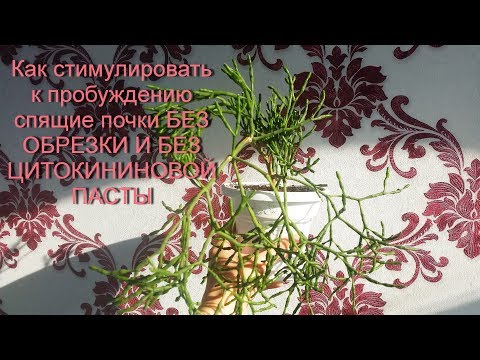

Watch this video on YouTube
Reproduction methods
Cuttings
Indoor hathiora can be propagated very easily and quickly by cuttings. Any segment broken off from the stem can be used as a cutting, and it can give roots right there in a pot next to the parent bush. In order to propagate the flower in this way, when it fades, 3 or 4 segments are carefully unscrewed from the shoot. In the resulting cutting, you need to treat the wound with crushed charcoal and let it dry in the open air for 3-5 days. Then the lower part of the segment is sprinkled with Kornevin and planted for rooting in a moistened soil mixture. Watering the cuttings is carried out only when the soil mixture is completely dry, while moistening it through the pan (bottom watering). If you properly care for a young plant, then the next year it will bloom.
Graft
For vaccination, hatiors use peresky prickly. This procedure is carried out in the summer. Trim the branched part of the rootstock and then split the stem. A hatiora cuttings used as a scion should have 2 or 3 segments. Its lower part should be sharpened with a wedge, after which it is installed in the split of the rootstock trunk, fix the grafting site with a plaster. It will be possible to remove the bandage only when the scion begins to grow. If, where the bush will be, the air temperature will be 18–20 degrees, then the scion can take root after 15–20 days. Those stems that grow below the grafting site should be cut off. Such bushes, propagated by grafting, bloom very profusely.
Diseases and pests of hatiors
Pests
Pests such as scale insects, mealybugs and spider mites can settle on the hatior. All such pests are sucking, that is, they bite through foliage or shoots and suck the plant sap out of them. To get rid of such pests, the bush will need to be sprayed 3 times with a solution of an acaricidal drug, for example, Akarin, Fitoverma or Agravertine. However, before spraying in a container with a flower, the top layer of the soil mixture is replaced with a fresh one.
Diseases
If liquid stagnates regularly in the container, this can cause the formation of rot. As a result, the stem becomes soft and brown. If you notice signs of rot, then you will have to get rid of the bush, since it is impossible to save it. However, if you wish, you can root the unaffected part of the shoot.
Also, this plant is susceptible to late blight. In the affected bush, the shoots discolor, turn gray, wither and rot. To save the bush, it must be sprayed with Oxyhom, but the treatment should be carried out in a timely manner.
Why hatiora doesn't bloom
Sometimes the plant either does not bloom at all, or blooms very poorly. This can happen for various reasons, or rather, there are two of them: an overly tight pot, or during the dormant period, the bush was not looked after correctly, and the budding did not occur. Remember that in winter, the bush should be at a temperature of 10 to 16 degrees, and it cannot be fertilized, and watering is reduced to scarce.
Why does hatiora turn yellow
Shoots turn yellow if pests have settled on the plant or watered too abundantly. After the cause of this problem is found, try to fix it as soon as possible, then you have a chance to save the hatior.
Types of hatiors with photos and names
At home, of all types of hatiors, the most often found are those described below.
Hatiora salicornioides
Or hathiora salicorniform, or saliciform, or saltwort. This is the type species of the genus. Such a highly branching plant outwardly looks like a small tree, the height of which is about 0.4 m.This species differs from others in that its shoots are thin, round in cross-section, and they include kegle-shaped segments (for this, the British also call such a hatiora "Drunkard's dream"). In spring, small apical flowers of red, pink or yellow appear on the bush. Their shape is bell-shaped.
Hatiora rosea
In contrast to the hatiora salicata in this species, flat reddish-green shoots have a club-shaped or elliptical shape. Large pinkish flowers reach 30 to 40 mm in diameter.
Hatiora herminiae
In this plant, shoots are arched or straight, they reach about 0.3 m in length. They include dark green segments, cylindrical in cross-section, the length of which is 20-50 mm, and they reach 5 mm in diameter. The flowers are crimson.
Hatiora gaertneri
Shoots consist of segments, the length of which is about 70 mm, with small notches along the edge. Sharlakhovy-red funnel-shaped flowers reach about 50 mm in diameter.
Hatiora graeseri
This hybrid was created by crossing Hatiora Gartner and Hatiora pink. The petals of flowers are painted in burgundy-red shades. However, during the reclamation, other shades began to appear.
Hatiora pentaptera
Outwardly, the plant looks like a small shrub. Its shoots are pentahedral, and the flowers are small and white.
Signs associated with hatiora
Since the hatiora has an unusual appearance, it has received a large number of nicknames among the people, for example: men's tears, dancing bones, the dream of a drunkard, etc. Some growers are afraid to grow such a spectacular flower in their home, as there are rumors about it that he is able to expel any man from the house. Believe it or not is a personal matter for every person. But at least it hasn't been scientifically proven.


Watch this video on YouTube

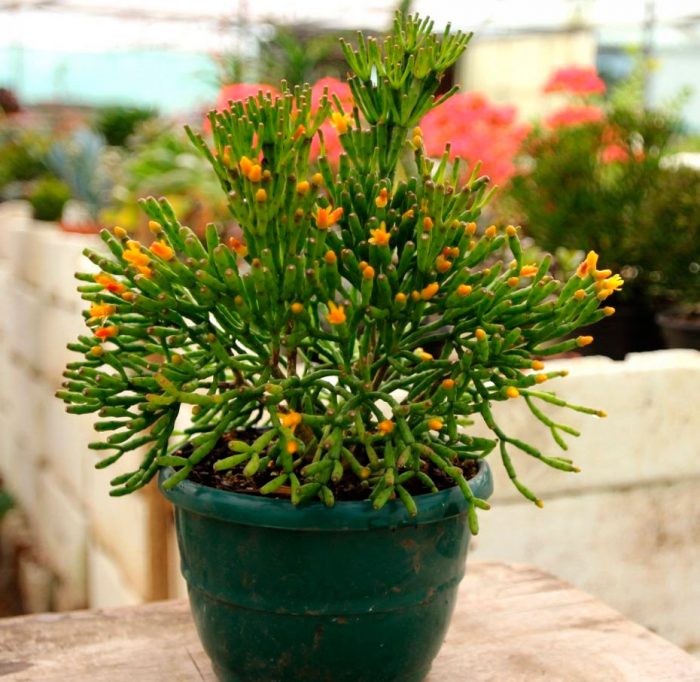
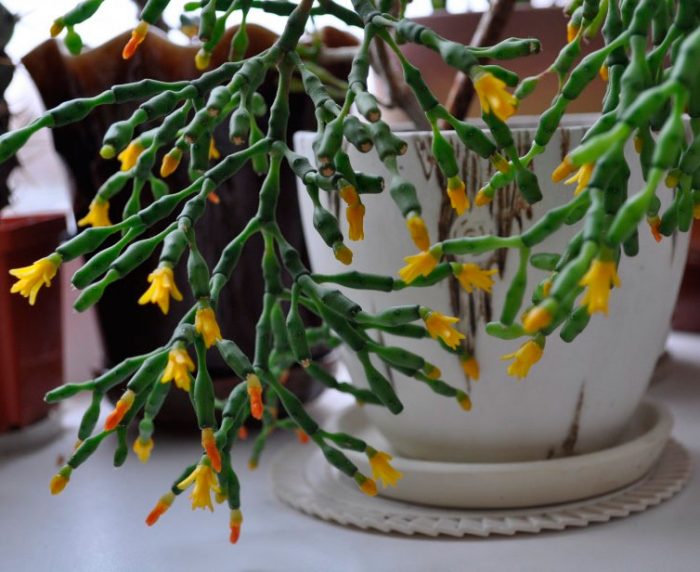
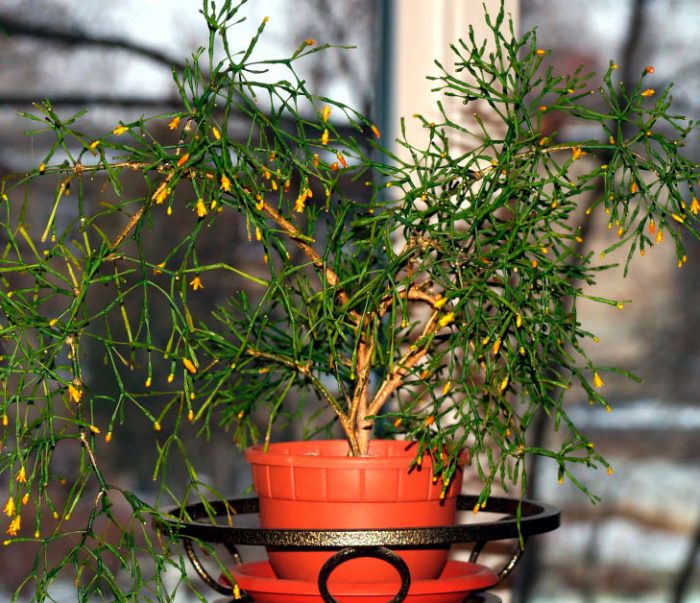

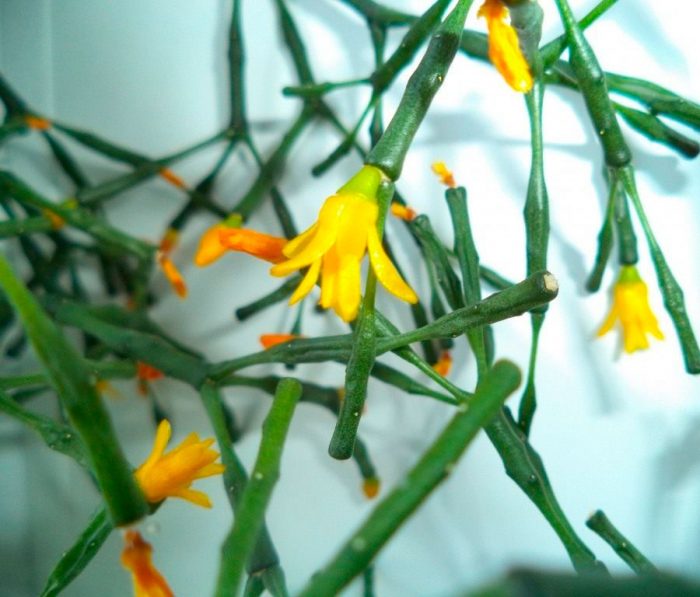
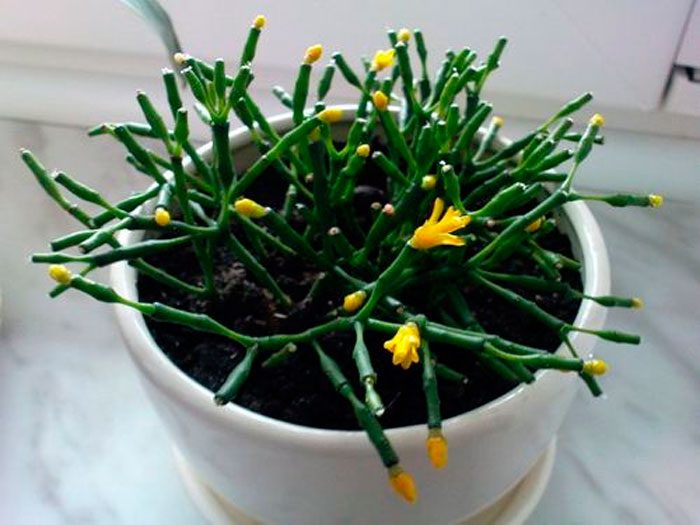
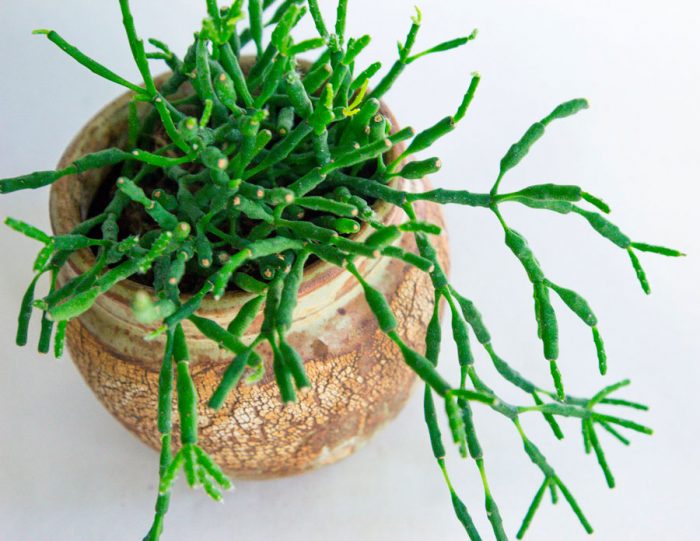
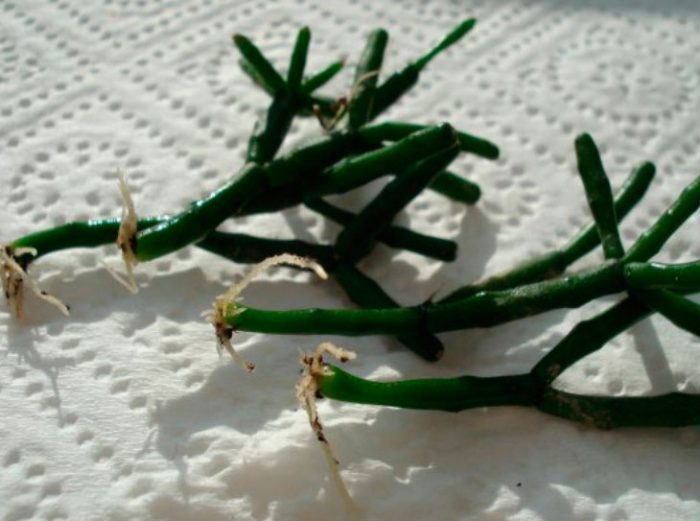
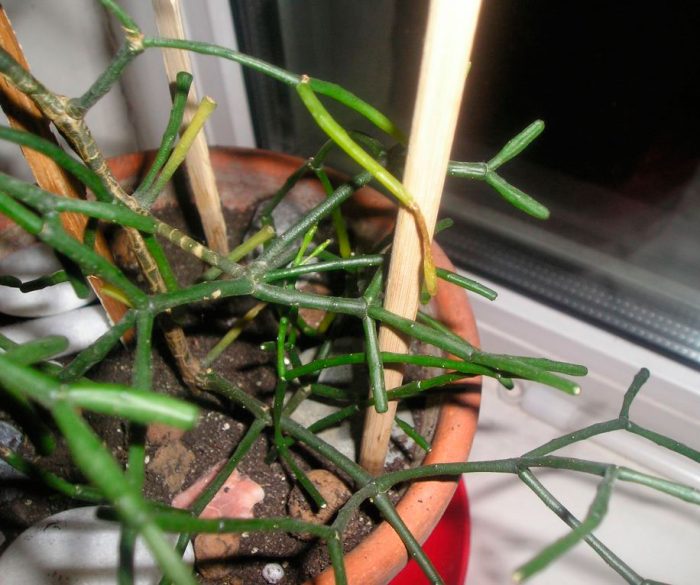
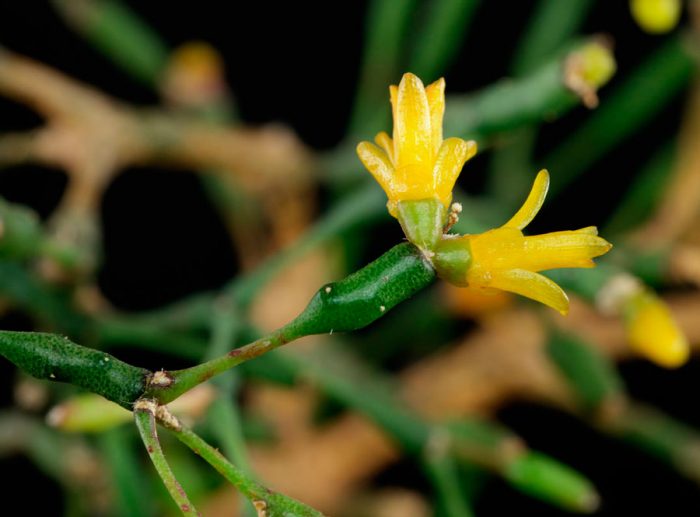
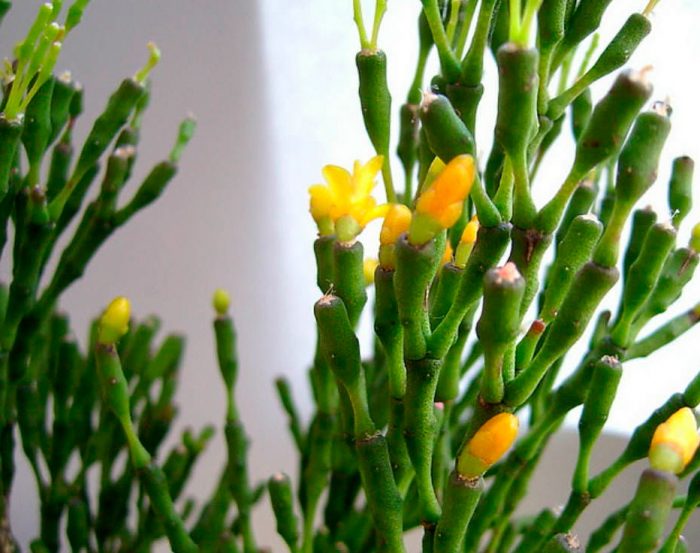
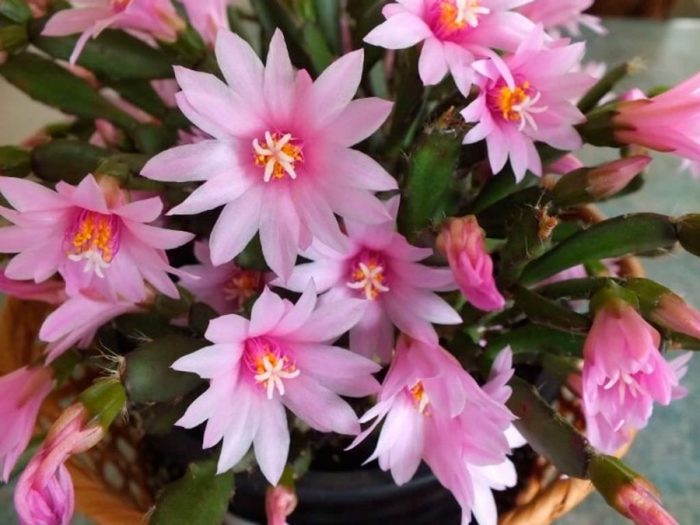
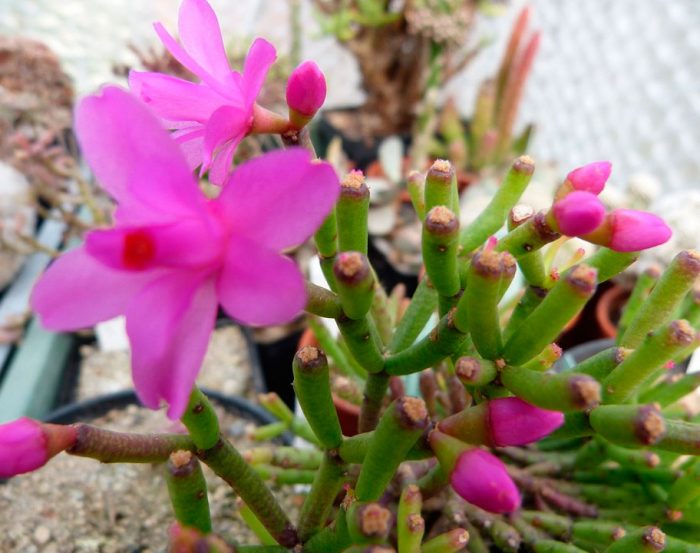
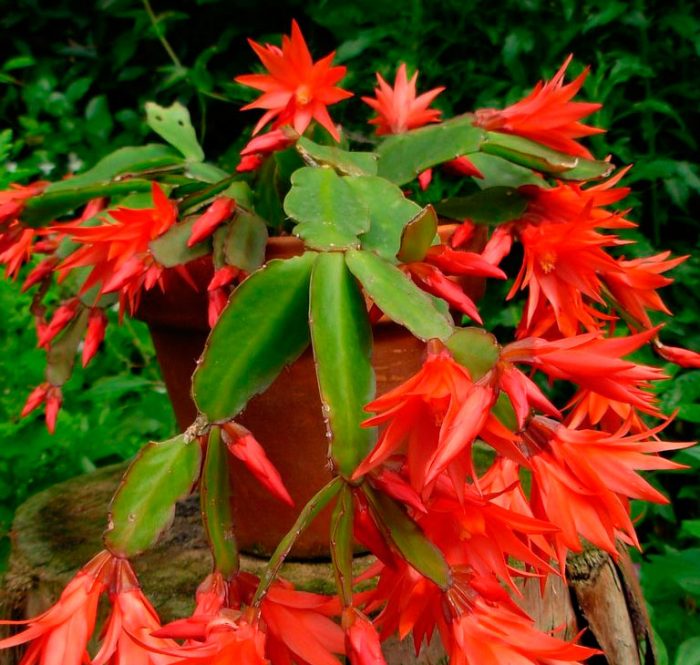
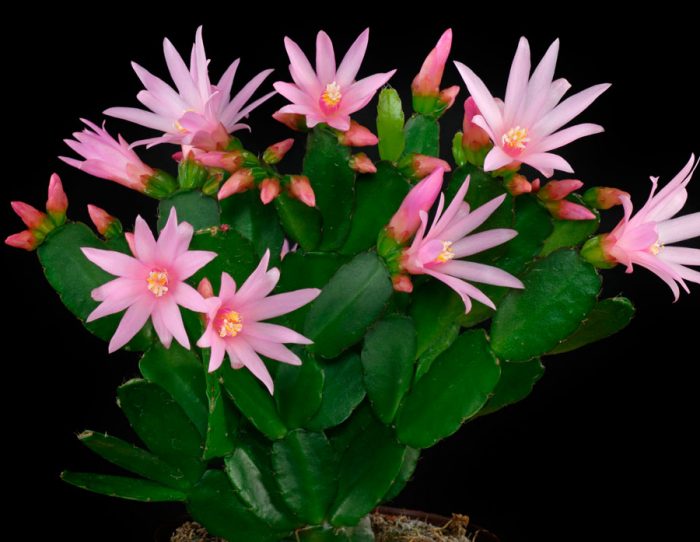
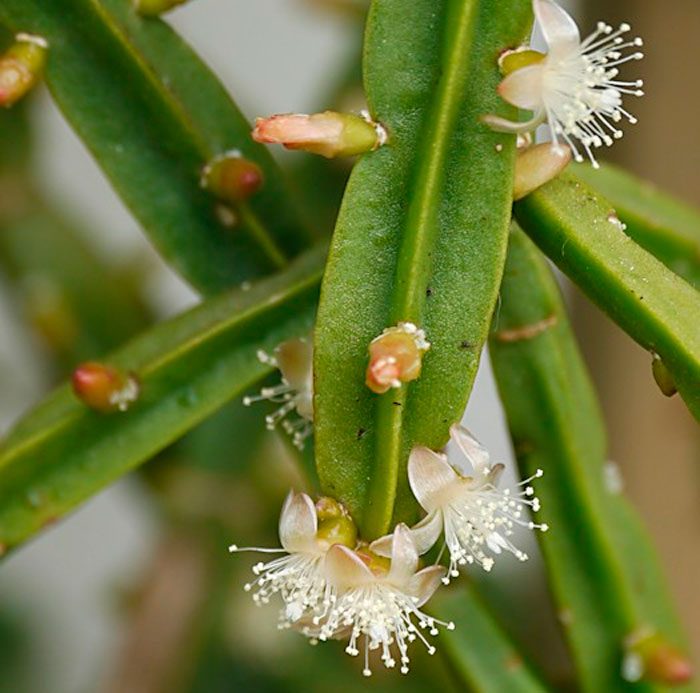



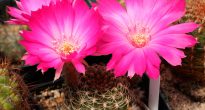






Hatiora immediately reminded me of the Decembrist. And the last photos are almost 100% Decembrist. What is the difference? Both have such leaves and flowers, maybe the photo is still a Decembrist?